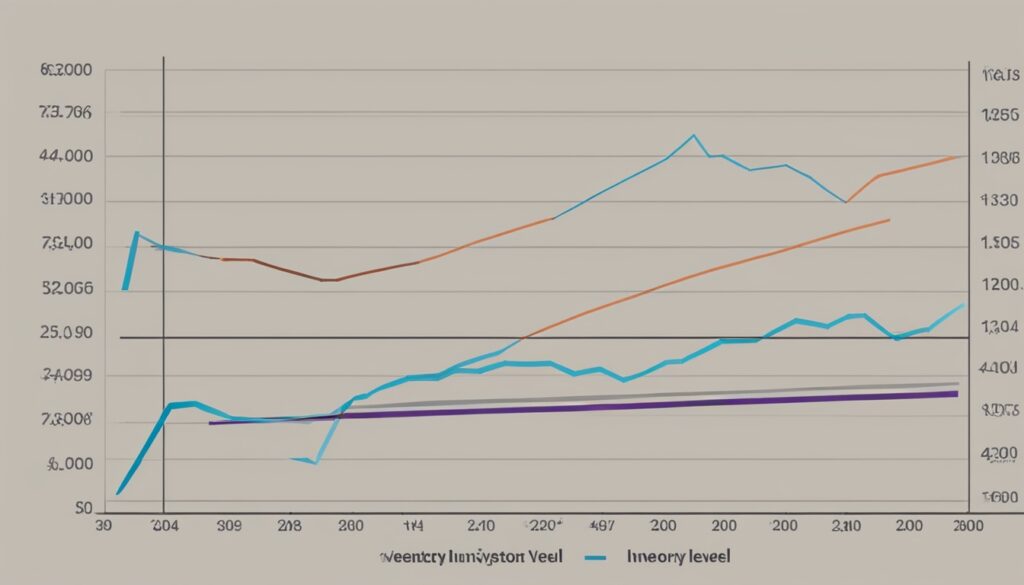Is keeping your inventory in check a challenge? Do you worry about having too much or too little stock? Many businesses, like yours, face these issues. Proper inventory forecasting is key for success in the Philippines.
We’re going to talk about specific inventory forecasting methods for businesses in the Philippines. These strategies help improve how you manage your stock. They lead to better customer service and more profit.
It’s not just small businesses; even big companies need to forecast their inventory well. This is crucial for keeping up in today’s fast-changing market. Knowing how much stock you need stops you from over or under ordering.
Key Takeaways:
- Inventory forecasting is vital for Philippine businesses to optimize their inventory levels.
- Accurate inventory forecasting leads to improved customer satisfaction and higher profitability.
- Tailored strategies for Philippine businesses consider unique market conditions and customer preferences.
- Implementing effective inventory forecasting helps businesses stay competitive and avoid stockouts or excess inventory.
- By accurately predicting demand, businesses can optimize procurement, production, and distribution processes.
The Importance of Accurate Inventory Forecasting
Accurate inventory forecasting is crucial for business success. It allows companies to predict future demand and adjust their stock levels. This optimization helps in reducing costs and improving overall efficiency. We will look into why accurate forecasting is important and how it boosts profits and customer happiness.
Impact on Margins and Customer Satisfaction
Getting forecasting right boosts a company’s profits by keeping just enough stock. Too much stock can be costly, leading to lower profits. But if there’s not enough, you might miss sales, hurting your business. Good forecasting finds the sweet spot, helping companies save money and make sales.
It’s key to more than profits. When businesses meet customer demand without running out of stock, customers are happy. This leads to more return customers. It’s all about giving customers a good experience by always having what they need on time. Doing this well builds customer trust and loyalty, giving your business an edge.
The Art of Forecasting for Business Success
Forecasting is a mix of art and science. It uses sales data, market trends, and looks at when certain products sell most. To get it right, you need to understand your market and customers well.
It combines models, data tools, and people making smart estimates. While tech helps a lot, human insight is still vital. This insight helps in making sure the predictions are accurate.
With accurate forecasting, operations run smoother, and profits rise. It arms businesses with the information they need to buy, plan, and manage stock well. This leads to better efficiency and performance.

Understanding Inventory Forecasting
Inventory forecasting is crucial for all businesses. It helps estimate future demand. This makes companies able to manage their inventory well, cut costs, and make customers happier.
Defining Inventory Forecasting for SMEs
For SMEs in the Philippines, keeping up with inventory is key to their success. They use past sales, market trends, and other info to guess the future demand.
This process helps SMEs prevent running out of stock, lower extra inventory, and boost their supply chain. By staying ahead in their inventory, they can use money and resources better.
Comparing Inventory Forecasting and Replenishment
Inventory forecasting and replenishment have different roles.
Inventory forecasting looks into predicting what customers will want next. It uses old sales, models, and insights to plan ahead.
Inventory replenishment is about ordering more stock before it’s too late. This ensures the right amount of supplies are always on hand.
Understanding both is vital for a smart inventory strategy. It combines the right amounts of forecasting and restocking to keep inventory levels perfect and items in stock.

By improving how they forecast inventory needs and replenish these needs, businesses can get more efficient. This saves money and keeps customers happy.
The Role of Demand Planning in Inventory Optimization
Demand planning is key for Philippine businesses to manage their stock well. It helps them forecast what customers will need. This way, they can make sure their shelves are stocked just right. This saves on costs, makes customers happier, and boosts their business success.
To plan demand well, businesses look at what’s trending in the market. They try to figure out what customers might want now and in the future. This lets them fine-tune their stocks to match what’s in demand.
They also keep a close eye on how demand changes seasonally. For instance, some products might sell better in the summer than in the winter. By predicting these ups and downs, they can keep their shelves from getting too full or too empty at the wrong times.
Understanding what customers like is crucial too. It helps businesses stock the right items. This keeps shoppers happy and makes sure they don’t miss out on sales because they’re either out of stock or overstocked.
The key to successful demand planning is a holistic approach that takes into account market trends, seasonal fluctuations, and customer preferences. By combining these factors, businesses can optimize their inventory levels and achieve significant cost savings.
The table shows how important demand planning is. Companies using these strategies have less costs and happier customers. But those that ignore it or predict wrongly face troubles like too much stock, high storage costs, or missing sales.
In the end, planning demand well is crucial for Philippine stores. It lets them adjust their stocks to fit what people are seeking. Doing this saves money, makes shoppers smile, and lifts their business up.
Inventory Forecasting Methods and Their Applications
Forecasting is key in managing inventory well. It helps businesses figure out the right amount of stock to keep. We will look at several forecasting methods that can make inventory control better.
Quantitative vs Qualitative Forecasting
Quantitative forecasting uses past numbers and math. It predicts what customers will want next. It’s great for businesses with lots of sales history and regular demand patterns.
Qualitative forecasting is based on people’s opinions. It helps when there’s not much sales data or the market is changing. Techniques like customer surveys and expert interviews are used. They give a deeper look into market trends and what customers like, helping businesses stay ahead.
Trend and Seasonal Considerations
Trends and seasons can significantly change how much customers buy. Knowing long-term trends can help a business prepare better. For instance, if a type of product suddenly gains or loses popularity, businesses can react fast.
Some businesses see big sales changes based on the time of year. Think of shops that sell items for specific seasons. They need to guess how much stock they’ll need for holidays or summer. Looking at past sales during these times helps them plan their stock levels right.

Steps to Forecast Inventory Effectively
Forecasting inventory well is key for businesses to work smarter and meet what customers want. By using these steps, you can make your inventory predictions better. This means you can make choices that push your business to succeed.
Analyzing Historical Sales Data
Looking at past sales is a big part of making good inventory forecasts. It lets businesses see patterns like when sales go up or down. This info helps figure out how much of what product is needed in the future.
- Notice when sales are the highest
- See if there are any surprises in the sales data
- Pick out the best and worst-selling items
By digging into past sales, businesses can wisely set their stock levels.
Integrating Market Intelligence
Understanding the market is crucial for forecasting well. It’s about keeping up with what customers like, what’s new in the industry, and market changes. Using this info, businesses can plan their inventory better to meet these changing demands.
Here’s how to mix market smarts into inventory planning:
- Stay on top of what customers want and how they buy
- Watch trends and keep an eye on competitors
- Use feedback from customers to improve
- Read market analyses to see the big picture
With market insights, businesses can choose which products to focus on, set up better promotions, and plan inventory smarter. This means fewer shortages, less wasted stock, and smoother operations.

| Benefits of Analyzing Historical Sales Data: | Advantages of Integrating Market Intelligence: |
|---|---|
|
|
Utilizing Predictive Analytics in Inventory Control
Predictive analytics boosts inventory control and forecasting. It uses math and tech to guess what products folks will buy. This helps stores keep just enough stock and avoid too much.
It lets businesses spot chances and risks early. They use past sales and trends to guess what’ll sell next. Then, they adjust how much stock they keep based on that info.
It’s great for avoiding having too little or too much stock. By guessing what people will buy, stores make sure they have the right amount of stuff. This means not wasting money on things that won’t sell.
Advanced tools get even better at guessing over time. They look at lots of data to make really accurate predictions. This includes stuff like past sales, what customers like, and what’s happening in the market.
Let’s say a store sells more in summer than winter. By looking back at what happened, and factors like weather and promotions, it can plan better. This way, the store has the right amount of items both when sales are high and when they’re not.
This tech also finds hidden buying trends. For instance, it can see how a big sale or change in tastes might affect what people buy. Using this insight, stores can make sure they’re ready for shifts in demand.
To wrap up, predictive analytics is key in keeping stock just right. It helps businesses guess what people want to buy. With this, they can cut down on unwanted items, keep customers happy, and do better in business.
Inventory Planning with Real-Time Data
In today’s business world, key to staying ahead is smart inventory planning. It ensures companies can meet what customers want. Real-time data is a big helper here. It updates us on inventory, sales, and what customers are doing right now. This means we can make better and quicker choices.
Real-time data is always fresh info on how a business is doing. It tells us things like what’s in stock, what’s selling fast, and what we’re running out of. This knowledge lets us react fast to buying trends. We can then buy or move stocks smartly to keep up with demand.
The Power of Inventory Management Software
For making the most of real-time data, high-tech inventory management software is a must. It gives businesses a hub to keep an eye on their stock. It links smoothly with how they manage their supplies.
This software can do key inventory jobs automatically, from filling orders to figuring out what to stock next. It cuts mistakes, saving time and making everything run smoother. Plus, it collects data right from the sales counter, online shops, and the warehouse.
What’s really cool about this software is how it turns data into clear plans. Using smart number-crunching, businesses can spot trends and be ready for what’s coming their way. This helps keep a shop full but avoids spending too much on what’s not selling. And that’s great news for both the store and the customer.
How Technology Streamlines Stock Forecasting
Tech is a game-changer in guessing what stock to have. It uses fancy math and learns from what’s happened in the past. This makes forecasts much more accurate.
By getting the computer to do the guessing, companies save lots of time and effort. This means they have more focus on growing, like adding new items, and making prices just right for shoppers. It keeps the service we get as customers top-notch.
Plus, tech lets companies keep an eye on their stock plans all the time, adjusting as the market changes. Being so flexible means they can act fast when needed, avoiding having too much or too little stock. It’s a big win made possible by real-time data and smart software.
Thanks to real-time data and the latest in inventory software, companies are getting better at planning their stocks. This doesn’t just make business smoother – it helps them stand out in the marketplace. The role of technology in planning stock can’t be overstated. It’s making businesses smarter and more successful.
Strategies for Efficient Inventory Management
Good inventory management is key for businesses to run smoothly and make more money. Using the right strategies helps companies handle their stocks better, cut costs, and keep customers happy. Here’s what you should do:
- Demand-Driven Inventory Management: This smart method ties how much stock a business keeps with what customers actually want. By looking at current data and complex analysis, firms can order inventory just right. This way, there’s no extra stock sitting around unsold or any gaps in what’s available.
- Just-in-Time (JIT) Inventory: JIT keeps inventory costs low and waste to a minimum. With this system, companies get inventory shipments exactly when they’re going to use them, cutting down on keeping too much stuff in storage.
- ABC Analysis: Use ABC to figure out which items in your inventory are most important, based on their value. This means paying more attention to the goods that make the most money, ensuring they’re always available when customers want them.
- Efficient Warehouse Layout: A well-organized warehouse can do wonders for stock management. Ordering products by how often they’re needed and using the right storage methods makes finding and packing them easier. This cuts down on mistakes and makes everything run more smoothly.
- Regular Inventory Audits: Checking stock levels often helps catch any mistakes and keeps everything up to date. This means comparing what you actually have with what your records say you should, and fixing any differences. It’s a must for keeping your inventory spot on and spotting room for improvement.
- Collaboration with Suppliers: Good communication with suppliers is crucial for inventory to flow smoothly. Working closely with them can help predict stock needs better, cut down delivery times, and make sure you’re always stocked just right.
- Utilize Inventory Management Software: Using the right software can make inventory management much easier. These tools can track everything in real time, predict what you’ll need next, and make sure you always have enough stock on hand. This not only saves time but also money.
- Continuous Improvement: Always strive to do better when it comes to handling your stock. Regularly checking and fixing your inventory management processes based on data and feedback is how to keep ahead. Look at important numbers like how often you turn over your stock and the cost of carrying it to find places to get better.
Taking these inventory management steps seriously improves a business’s functions, makes customers happier, and increases profits. Remember, staying on top of these strategies and adjusting to meet new market trends and customer needs is vital.
Conclusion
Good inventory forecasting is key for success in the Philippines. This article highlighted how it boosts profits and keeps customers happy. With the right steps, businesses can keep the perfect amount of products in stock.
There are many ways to forecast, both numbers-based and more focused on trends. Looking at past sales and market trends helps with accurate predictions. Tools like predictive analytics and inventory software also play a big role.
Getting inventory forecasts right helps businesses save money and run smoothly. This leads to better customer service, less waste, and more money earned. In the modern market, using tech and data is a must to do well.
In the end, Philippine businesses need to get their inventory forecasts right. Using the best methods, including the latest tech, can make this happen. By looking at what customers want and running things efficiently, companies can succeed in the fast-changing market.
